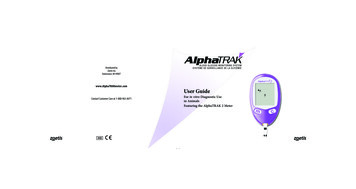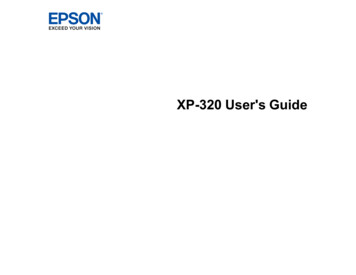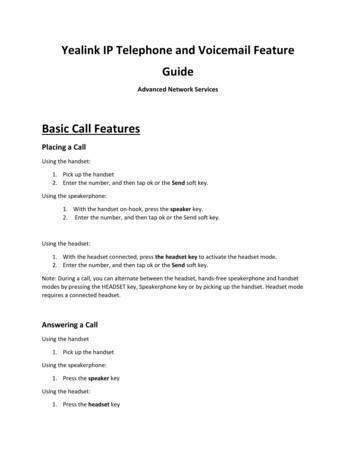Transcription
303132In pressTitle: Player tracking technology: half-full or half-empty glass?Submission type: Invited CommentaryAuthors: Martin Buchheit & Ben Michael SimpsonPerformance Department, Paris Saint-Germain Football Club, Saint-Germain-en-Laye, FranceRunning Head:Contact details:Martin BuchheitPerformance Department, Paris Saint-Germain Football Club,4a avenue du président Kennedy78100 Saint-Germain-en-Laye, FranceTel.: 33 1 61 07 10 77E-mail: mbuchheit@psg.frAbstract word count: 229Text-only word count: 3522Number of Tables: 0Number of Figures: 4Disclosures: nothing to disclose
283848586871. AbstractWith the ongoing development of (micro) technology, player tracking has become one of the mostimportant components of load monitoring in team sports. The three main objectives of player trackingare the following: i) better understanding of practice (provide an objective, a posteriori evaluation ofexternal load and locomotor demands of any given session or match), ii) the optimisation of trainingload patterns at the team level and iii) decision making on individual players training programs toimprove performance and prevent injuries (e.g., top-up training vs. un-loading sequences, return toplay progression). This paper, discusses the basics of a simple tracking approach and the need for theintegration of multiple systems. The limitations of some of the most used variables in the field(including metabolic power measures) will be debated and innovative and potentially new powerfulvariables will be presented. The foundations of a successful player monitoring system are probablylaid on the pitch first, in the way practitioners collect their own tracking data, given the limitations ofeach variable, and how they report and utilize all this information, rather than in the technology andthe variables per se. Overall, the decision to use any tracking technology or new variable shouldalways be considered with a cost/benefit approach (i.e., cost, ease of use, portability, manpower /ability to impact on the training program).2. IntroductionWith the ongoing development of (micro) technology, player tracking has become one of the mostimportant components of load monitoring in team sports.1 The scientific literature has grownexponentially over the last decade, and it is very difficult to find an elite team not using the minimumof GPSs, semi-automatic camera or radio-frequency systems, either in isolation or in combinationduring both training and matches.1 The three main objectives of player tracking are likely thefollowing: i) better understand practices (provide an objective, a posteriori evaluation of external loadand locomotor demands of any given session or match), ii) help with the programming of optimaltraining load patterns at the team level and iii) help with the decision making on individual playerstraining programs to improve performance and prevent injuries (e.g., top-up training vs. un-loadingsequences, return to play progression). While such technological advances are of evident value forpractitioners and players, limitations in terms of validity and on-field usefulness are still oftenoverlooked. There is also a feeling that people may adopt new technologies and new variables beforevalidity, reliability and usefulness had been properly evaluated. Early and naïve adopters may oftenthink that i) technology in itself is a solution, and ii) if they do not use the newesttechnologies/variables immediately they may fall behind competitors. In fact, most of the time, theintroduction of new technologies and monitoring variables adds complexity and slows down systems,rather than improving them. In the present paper, we discuss the basics of a simple tracking approachand the need for the integration of multiple systems. Furthermore, we highlight the limitations of someof the most used variables in the field (including metabolic power measures) and present someinnovative and powerful variables2 that may be of importance for the future.3. Integrating various systemsWhile the precise analysis of each training sequence (drill database3) is of infinite value forimproved training prescription and programming both at the individual and team level, the simplemonitoring of players overall external (locomotor) load is probably one of the most important aspectsof any monitoring system.1 There has been growing evidence to suggest that tracking overall trainingload accumulation during pre-season and/or its acute changes over the time (spikes in load, referring tothe so-called training stress-balance or acute-to-chronic load ratio) may be key in better understandinginjury risk.4 Using the example of soccer (Figure 1), it is not unusual for some players to be tracked by2 to 3 systems during the same week. This is likely related to the fact that GPS units, local positioningsystem (LPM) or radio-frequency identification (RFI) sensors are often worn during training sessions,while most teams still use semi-automatic camera systems during official matches.5 Since a perfectbetween-system agreement in terms of locomotor activity (e.g., distance covered, number ofaccelerations) is problematic,5 simply providing a cumulative summation of the data gathered by thedifferent systems6 is highly hazardous. To allow a proper evaluation of a player’s overall locomotor
1142load, and to integrate accordingly the data of different systems, practitioners are recommended to usecalibration equations.5 Such equations are meant to predict, for example, the running distance thatwould have been measured with a given system (e.g., GPS), while it was actually measured withanother one (e.g., semi-automatic cameras during a match). While such equations are sometimesprovided in the literature from large scale studies with players tracked simultaneously using differentsystems under different conditions (e.g., training, matches over different pitch size),5 their usefulnessis somewhat limited to the actual systems used to derive those equations; it is therefore advised thateach practitioner develop their own equations using their own systems. It is also important thatpractitioners re-adjust these equations when updates in their technology occur (see 3.2).7 The mostrelevant variables to integrate will be discussed in the following section.4. Tracking accelerations and high-speed running: time to slow down?4.1. Which variable to choose from?Considering that the ideal system does not exist yet, and that all systems have their ownadvantages and disadvantages, whilst still all providing more or less the same variables,5 it may bemore relevant to pick the most useful variables than to focus on the technology per se. To make asubstantial impact on the program, it is advised to focus on the variables that i) are simple enough tobe understood, and in turn, used by all practitioners at the club (ranging from the coach to players),and ii) are valid and reliable enough to be trusted when decisions have to be made. When it comes todescribing the different types of tracking variables available on the market, the classification of Gray2stands out. He uses three distinct levels: Level 1: Typical distances covered in different velocity zones (‘old school’ type of analysis,provided by all technologies). Example: 345 m ran above 19.8 km/h. Level 2: All events related to changes in velocity: accelerations, decelerations and changes ofdirections (provided with more or less success by all technologies). Example: 45 accelerationsover 3 m.s-2, for a total distance of 233 m. Level 3: All events derived from the inertial sensors/accelerometers (micro-technology only,so unavailable with camera-derived systems). Examples: 17 impacts above 6 G, Player Loadof 456 AU, stride variables (Force load on the ground, contact times), stride imbalances (4%reduced impulse force on the right leg).8,9In a recent meta-analysis,1 total distance, high-speed running, acceleration/decelerationpatterns and metabolic power (MP) were the variables that were rated as the most important for eliteteam practitioners. Total distance is generally used as a proxy of overall training volume. High-speedrunning distance (also called stride work, which involves high activation of hamstring muscles) andacceleration/deceleration patterns (also called mechanical work, involving tight muscles) are believedto be the most important variables to be tracked since they refer to a more neuromuscular-orientedtype of load, which is likely more linked with injury risk.3,10,11 Metabolic power is a hybrid measurebased on both Level 1 and 2 types of variables, and is meant to provide a good estimate of the overallcost of high-intensity actions while combining the actual cost of high-speed (Level 1) and accelerated(Level 2) running.12 Unfortunately however, practitioners are left with a difficult dilemma whenselecting their variables, since their validity and reliability is likely inversely related to theirimportance in terms of load monitoring, i.e. high-speed running, acceleration/deceleration work andmetabolic power being the least valid and reliable variables.1,13 In other words, the variables that arebelieved to be best are likely the least useful.2 This does not mean that those variables should not bemonitored, but rather suggests that greater care should be taken when interpreting their differences orchanges (i.e., defining a larger, more conservative smallest worthwhile difference/change).14 Also, avariable with a limited validity can still be useful if it is clearly sensitive to training or fatigue (whichrefers to a large signal-to-noise ratio).15It is now very clear that activity patterns of players is more dependent on tactical issues (rules,coaches’ interventions, score line) than influenced by their current fitness status.16 For this reason,locomotor-related variables (Level 1 and 2) may not be suitable for the monitoring of training status;in contrast, Level 3 types of variables can be collected irrespective of players’ activity on the pitch,and have greater potential for the monitoring of fitness and fatigue (see part 5).8 It is however worthnoting that when Level 3 variables are not available (using semi-automatic cameras or some GPS
2193194195196brands which do not provide such variables), some relevant information can still be gained with Level1 and 2 variables - but only in the very specific context of highly standardized drills.17 Figure 2 showshow a player’s readiness to perform could be assessed during congested fixtures using simple runningperformance indicators during highly-standardized drills, i.e., during match simulation drills the daysbefore matches (in the context of similar small-sided game formats, number of players and drillduration). Results show that the longer the between-match recovery period, the greater the matchsimulation activity, which mirrors the physiological and performance recovery processes in the 2-3days following macthes.184.2 Limitations of common tracking variables, with special references to GPS systems.In addition to potential validity and reliability issues, there are other important limitations to considerwhen using some of these tracking variables, including: Accelerations values are directly related to the time-window (duration over which theacceleration is measured, in general between 0.2 and 0.8 s, Figure 3)) and the signal filteringtechnique used.13 There is unfortunately no consensus on the optimal time-window and filterto use. A simple and relevant alternative to the use of arbitrary time-windows could be toreport acceleration over a meter (i.e., the base unit of length in the International System ofUnits).19 Companies often update their data processing technique (software or unit chipset updates),which can create large differences in data output.7 It is therefore almost impossible to holdhistorical databases, unless you never update your system. The number of GPS satellites available and their spread in the sky (geometric dilution ofprecision (GDOP), with the greater the spread of the satellites, the better the signal quality) inresponse to variations in time of day, location on earth or possible infrastructures (stadiumroofs may cause partial blockage); unfortunately, however, activity reports do not readilyprovide this detailed information, leading to a potentially unclear representation in theirreadings. There are large differences in GPS distance recorded when using the Doppler technique vs.local coordinates – while the Doppler tends to be the preferred method today, someinconsistencies remain between brands. The validity of accelerations and distance into speed zones is acceleration-20 and speed-5dependent; i.e., their validity decreases as the acceleration and speed increase. So to speak,variables of most importance are likely the least useful. Increased sampling frequency does not always translate into better precision and validity.5 There are large between-unit variations (up to 50%), even between units from the samebrands.7 The direct consequence is that players should always use the same unit, and weshould always remain cautious when comparing different players’ data (and use largermagnitude thresholds for meaningful differences14).4.3 Metabolic power: powerful enough to drive Ferraris?Since Osgnagh et al. in 2010,12 showed the potential application of the metabolic power (MP)concept21 for load monitoring in soccer, the interest for this variable has grown exponentially and isnow used across many other team sports.22-25 In fact, most GPS brands now offer the ability to monitorplayers’ MP, and a majority of practitioners use this variable when reporting.1 While we26 have beenthe first to be excited about the potential of this monitoring approach, we have since reconsidered ouropinion and now question its usefulness in the field to monitor elite players (i.e., “Ferraris”). This isessentially related to i) recent research findings questioning the validity of this construct in the contextof team sports-specific movements and ii) the fact that it is only an incomplete metabolic measure ofinternal load and a too broad marker of external load.4.3.1 What are we measuring in the end?It has now been shown by four distinct and independent research groups that locomotor-relatedMP assessed via either GPS or local positioning system (PGPS) differs largely from the true metabolicdemands as assessed via indirect calorimetry (VO2 measures, PVO2). PGPS was actually reported to bevery largely greater than PVO2 during walking,27 but very largely lower during shuttle runs at low
6247248249250251speed28 and during soccer-,26 rugby-29 or team-sports27 specific circuits. While some may see theconsistency of such conclusions as a kind of consensus, Osgnach et al.30 suggested that somemethodological errors may explain the underestimation of PGPS reported.26-29 Among others, theyattributed our discordant results to i) the inclusion of resting VO2 when calculating PVO2 (while wehave in fact used net VO2, as clearly written p1151, 2nd paragraph26), ii) the impact of non-locomotoractions on PVO2 (while team sports often include intense but static movements that logically increasesystemic energy expenditure (PVO2) independently of locomotor movements (PGPS)31), iii) anunderestimation the anaerobic contribution to PVO2 (while if we had better accounted for the entireanaerobic contribution to PVO2, the PGPS underestimation that we reported would have been evengreater, not smaller31) and iv) our 4-Hz GPS sampling frequency (while the other researchers have allreported the same underestimation using higher sampling frequencies i.e., 500,28 1029 and 527 Hz).Note also that we have shown that sampling frequency per se was not the most important factors whenit comes to precision and validity.5 Detailed and illustrated answers to these four points have beenoffered elsewhere,31 and confirm the limitations of PGPS in the context of interest, i.e., monitoringteam-sports specific efforts with the available technology on the market.4.3.2.Adding value to load monitoring systems?Considering that the agreement between PGPS and PVO2 has only been shown to be acceptableduring continuous and linear jog and runs (but neither during walking nor intermittent changes ofdirection runs)27, the metabolic underestimation consistently reported26-29 may be related to the factthat the current equation initially developed for maximal and linear sprint acceleration21 may not bewell suited for team-sport specific running patterns (e.g., including rest, irregular step frequency andstride length, turns, upper body muscle activity, static movements).26 Additionally, if PGPS was to onlyreflect locomotor-related metabolic activity (as opposed to a systemic measure such as PVO2), whatwould be the value of such an impartial measure of metabolic load? This is at odds with all attempts touse PGPS outputs for overall load monitoring or nutritional (post training/matches recovery)guidelines.25 Taken together, these limitations suggest that the value of PGPS per se to monitor trainingload in team sports may be questionable. Its usefulness may also be limited with respect topractitioners’ expectations in the field. In fact, practitioners are likely seeking for: Overall estimates of internal load, which are in our views satisfactorily assessed throughHR and RPE measures1 – information on the metabolic load of exclusively locomotorrelated actions as with PGPS may not be comprehensive enough. Precise measures of external load, which directly relate to specific mechanical constraintson players’ anatomy, which, in turn target specific muscle groups. This has directimplications for training, recovery and injury risk. However: PGPS is clearly dissociated from actual muscle activation, as exemplified by verylarge variations in the PGPS/EMG ratio during accelerated vs. decelerate running.19 PGPS, if it was to be used as a global marker of mechanical work (combining Level 1and 2 types of variables), would not decipher the underlying mechanisms of the load– we rather use distance while accelerating, decelerating and while running at highspeed since those variables may relate directly to the load of specific muscle groups. Injuries are most generally related to inappropriate volumes of accelerations10 orhigh-speed running;11 there is in contrast little evidence to suggest that spikes inoverall energy consumption per se may play a role in injury etiology.5.Where do we go from here?We wished to finish with the introduction of two innovative and promising types of variables(Athletic Data Innovation analyzer, ADI, Sydney, NSW, Australia),3,8 not cited in the meta-analysis,1that represent clear advances in terms of external load and fatigue monitoring. One of the greatestbenefits of these variables is that, in contrast to Level 1 and 2 variables that are pacing- or playerengagement-dependent, players do not need to perform maximally for these latter variables to beuseful. From there, every training session becomes an assessment. Force load (FL). With the ADI analyzer,3,8 Force load refers to the sum of estimated groundreaction forces during all foot impacts, assessed via the accelerometer-derived magnitudevector. In comparison with Player/Body Load9 (whole body load based on overall
1302303304305 6.accelerometer activity) or total distance, FL reflects only locomotor-related impacts andprovides better estimates of overall foot work and impulses, especially when the sessionsinclude static movements and little displacements (e.g., toros, football tennis, free kicks).a. In relation to the actual distance covered (TD/FL) or the average velocity (V/FL)during a given drill, Force load can be used for at least two purposes: i) assessneuromuscular/running efficiency (greater the ratio, better the efficiency) 32 and ii)provide new insights into the mechanical demands of on-field running drills, such asthe main direction of force application; i.e., large vs. small ratios standing for morehorizontal vs. more vertical forces applications, respectively, Figure 4). As shown inFigure 4, when comparing for the first time the mechanical demands of different 15-msprint conditions, the V/FL ratio decreases with the increased need for horizontal forceproduction.b. Force load can also be compared between right and left legs, and stride imbalance canbe tracked during any type of locomotive actions (e.g., specifically while acceleratingvs. running at high speed, which likely relates to the use and potential weaknesses ofdifferent muscle groups).8 This is obviously very relevant during the return to playperiod (Figure 5) and to track eventual muscle strength deficits in yet healthyplayers.33Stride characteristics (contact and flight time, also calculated from accelerometer data). Fromthese simple variables it is now possible to accurately calculate vertical stiffness,8 which hasbeen shown to decrease substantially with neuromuscular fatigue.34,35 The constant monitoringof stride characteristics (or at least ground impact-related lower leg vertical activity36), morepreferably during standardized running bouts,32 offers a new alternative to the V/FL ratio andprovides new perspectives for the field monitoring of neuromuscular status. Another verypractical aspect of the present stride variables is that accelerometers can be used indoor (i.e.,no GPS signal needed), allowing their use for almost every type of run-based type of sports(e.g., basketball, handball).ConclusionMonitoring players’ overall external training load is only possible through the integration of thedifferent technologies used in combination in most clubs (e.g., GPS and semi-automatic cameratracking for training and matches, respectively).5 Until new solutions are developed, the use of clubspecific calibration equations is probably the “lesser of all evils”, but practitioners would still be facedwith the downside of technology and/or computing advances (e.g., firmware or software updates), 7which ultimately compromises long term monitoring plans. When it comes to monitoring trainingstatus, Level 1 and 2 tracking data may only be worthy in the context of highly standardized drills.17 Incontrast, pacing-free Level 3 variables (e.g., stride parameters, Force load8) may offer a greatersensitivity, although more research is still warranted to confirm this hypothesis. Considering that theperfect tracking system still does not exist,5 and given the numerous limitations of the most advocatedvariables (accelerations, metabolic power, see section 3), the foundations of a successful playersmonitoring system should focus on the manner in which practitioners collect their own tracking data,their understanding of the limitations of each variable, and how they report and utilize all thisinformation, rather than in the technology and the variables per se. Furthermore, the validity andreliability and the practical interpretation of tracking variables should never be overlooked; the mostuseful tracking variables are very likely those that can be understood and in turn, used by allpractitioners at the club. Our opinion is that before adopting new pieces of technology or variables,practitioners should assess their usefulness first, in order to ensure worthwhile incorporation into theirprogram. Overall, the decision to use any tracking technology or new innovative variable shouldalways be considered with a cost/benefit approach (i.e., cost, ease of use, portability, manpower /ability to impact on the training program). Technology should be preferred over simpler methods onlywhen unique and important information can be obtained (e.g., the percentage of maximal speedreached during a session, which may directly impact injury risk,37 can’t be assessed via session-RPE).Anecdotally, very successful coaches still make most of their decisions based on information as simpleas accumulated training and playing time! We are nevertheless confident that in the future, with the
7306307308advances in terms of micro technology, the development of new tracking variables and appropriatesport-science support,38 even those coaches would start to see the glass half-full.
83597. 7.18.19.20.Akenhead R and Nassis GP. Training Load and Player Monitoring in High-Level Football:Current Practice and Perceptions. Int J Sports Physiol Perform. 2016;11:587-593.Buchheit M. Player tracking technology: what if we were all wrong? In: Monitoring AthleteTraining Loads - The Hows and Whys Doha, Qatar: 2nd Aspire sport science conference,https://vimeo.com/159904163, 2016.Colby M, Dawson B, Heasman J, Rogalski B, and Gabbett TJ. Training and game loads andinjury risk in elite Australian footballers. J Strength Cond Res. 2014.Gabbett TJ. The training-injury prevention paradox: should athletes be training smarter andharder? Br J Sports Med. 2016;50:273-280.Buchheit M, Allen A, Poon TK, Modonutti M, Gregson W, and Di Salvo V. Integrating differenttracking systems in football: multiple camera semi-automatic system, local positionmeasurement and GPS technologies. J Sports Sci. 2014;32(20):1844-1857.Anderson L, Orme P, Di Michele R, Close GL, Morgans R, Drust B, and Morton JP.Quantification of training load during one-, two- and three-game week schedules inprofessional soccer players from the English Premier League: implications for carbohydrateperiodisation. J Sports Sci. 2016;34:1250-1259.Buchheit M, Al Haddad H, Simpson BM, Palazzi D, Bourdon PC, Di Salvo V, and MendezVillaneuva A. Monitoring accelerations with GPS in football: time to slow down? Int J SportsPhysiol Perform. 2014;9:442-445.Buchheit M, Gray A, and Morin JB. Assessing Stride Variables and Vertical Stiffness with GPSEmbedded Accelerometers: Preliminary Insights for the Monitoring of NeuromuscularFatigue on the Field. J Sports Sci Med. 2015;14:698-701.Barrett S, Midgley A, and Lovell R. PlayerLoad: reliability, convergent validity, and influenceof unit position during treadmill running. Int J Sports Physiol Perform. 2014;9:945-952.Bowen L, Gross AS, Gimpel M, and Li FX. Accumulated workloads and the acute:chronicworkload ratio relate to injury risk in elite youth football players. Br J Sports Med. 2016.Duhig S, Shield AJ, Opar D, Gabbett TJ, Ferguson C, and Williams M. Effect of high-speedrunning on hamstring strain injury risk. Br J Sports Med. 2016.Osgnach C, Poser S, Bernardini R, Rinaldo R, and di Prampero PE. Energy cost and metabolicpower in elite soccer: a new match analysis approach. Med Sci Sports Exerc. 2010;42:170178.Haugen T and Buchheit M. Sprint Running Performance Monitoring: Methodological andPractical Considerations. Sports Med. 2015.Buchheit M. The Numbers Will Love You Back in Return-I Promise. Int J Sports PhysiolPerform. 2016;11:551-554.Buchheit M. Monitoring training status with HR measures: do all roads lead to Rome? FrontPhysiol. 2014;27:73.Carling C. Interpreting physical performance in professional soccer match-play: should we bemore pragmatic in our approach? Sports Med. 2013;43:655-663.Buchheit M, Racinais S, Bilsborough JC, Bourdon PC, Voss SC, Hocking J, Cordy J, MendezVillanueva A, and Coutts AJ. Monitoring fitness, fatigue and running performance during apre-season training camp in elite football players. J Sci Med Sport. 2013;16:550-555.Nedelec M, McCall A, Carling C, Legall F, Berthoin S, and Dupont G. Recovery in soccer: part I- post-match fatigue and time course of recovery. Sports Med. 2012;42:997-1015.Hader K, Mendez-Villanueva A, Palazzi D, Ahmaidi S, and Buchheit M. Metabolic PowerRequirement of Change of Direction Speed in Young Soccer Players: Not All Is What It Seems.PLoS One. 2016;11:e0149839.Akenhead R, French D, Thompson KG, and Hayes PR. The acceleration dependent validity andreliability of 10 Hz GPS. J Sci Med Sport. 2014;17:562-566.
.24.25.26.27.28.29.30.31.32.33.34.35.36.37.38.di Prampero PE, Fusi S, Sepulcri L, Morin JB, Belli A, and Antonutto G. Sprint running: a newenergetic approach. J Exp Biol. 2005;208:2809-2816.Cummins C, Gray A, Shorter K, Halaki M, and Orr R. Energetic and Metabolic Power Demandsof National Rugby League Match-Play. Int J Sports Med. 2016;37:552-558.Malone S, Solan B, Collins K, and Doran D. The metabolic power and energetic demands ofelite Gaelic football match play. J Sports Med Phys Fitness. 2016.Vescovi JD. Locomotor, Heart-Rate, and Metabolic Power Characteristics of Youth Women'sField Hockey: Female Athletes in Motion (FAiM) Study. Res Q Exerc Sport. 2016;87:68-77.Coutts AJ, Kempton T, Sullivan C, Bilsborough J, Cordy J, and Rampinini E. Metabolic powerand energetic costs of professional Australian Football match-play. J Sci Med Sport.2015;18:219-224.Buchheit M, Manouvrier C, Cassirame J, and Morin JB. Monitoring Locomotor Load in Soccer:Is Metabolic Power, Powerful? Int J Sports Med. 2015;36:1149-1155.Brown DM, Dwyer DB, Robertson S
1 1 2 In press 3 4 Title: Player tracking technology: half-full or half-empty glass? 5 6 Submission type: Invited Commentary 7 8 Authors: Martin Buchheit & Ben Michael Simpson 9 10 Performance Department, Paris Saint-Germain Football Club, Saint-Germain-en-Laye, France 11 12 1











